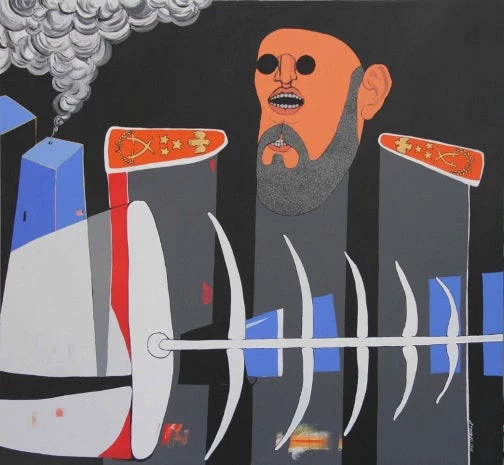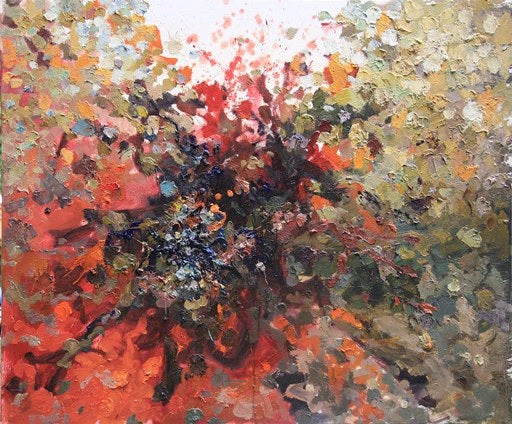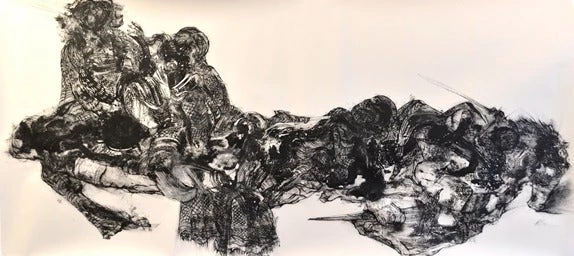After 3 years of war, themes of fragmentation, fatigue, and bloodshed all come across in the work of Syrian artists currently being exhibited at the World Bank.
Collectively, their paintings convey a sense of the internal turmoil caused by external violence, paintings that hint at conflict: the skeleton beneath the skin, a fractured womb, being caught in a trap like a fly, the scarlet gashes of torn flesh, and sinister handcuffs, to name a few subjects.
Join us April 9th, 2014, for the opening of the art exhibition featuring 35 paintings by 15 Syrian artists who were given the time and space to work at an artist residence in Lebanon.
Get a glimpse of the paintings here:
The End
“With the outbreak of events in Syria in March 2011, I started a series of drawings reflecting violence and daily death. Gradually my leitmotifs became more pronounced, the monster turned into a dictator for example, and an abstract of a tormented person turned into a contemporary Syrian man.” - Mohamad Omran

We Are Not Numbers
“In We Are Not Numbers, I relied on my memory of drawings of children from Syria. The aim was to draw attention to the fact that children are not part of the war, to protect their memories from the acts of violence and the cruelties of armed conflict.” – Heba Al Akkad

Cuffs
“The handcuffs in this painting are a negative critique of the reality of dictatorship, the absence of freedom. Each cuff represents a human being, whom I try to depict in different states of mind.” – Rabee Kiwan

Shoes
“I used shoes to represent the human being of our times. The painting is an attempt to humanize the shoes, and it is a negative critique of our reality.” – Rabee Kiwan

Scream 3
“My paintings represent fatigue from the screaming of human beings. I remember when people were questioning why all this violence was happening. They still are, but now they are more tired and bored: tired of the color red, tired of this world, of the psychologically and physically disturbed people.” – Remy Al Haddad

Womb 3
“I saw the first fingers of my hand being formed in my mother’s womb; I could feel myself ... My first dream of freedom started here, my first longing to meet the light. There came my first scream for life, to send you my message and tell you my story, my passion for life, and how dearly I hold on to it.” – Reem Yasouf

Gloating
“My art explores the lack of humanity in the Syrian war. It is meant to expose men and women debased to their bone structure.” – Fadi Hamwi

Death Trip
“When I paint, I paint nature and its creatures automatically, free from sin, from filth and humanization. I enter the world of animal dreams for my creatures to come out, innocently imposing their inevitable existence on my canvas.” – Hasko Hasko

The Red Part of a Second
“My paintings are about events that take 1 second, a second so long that it could include many changes. And there are fragments that float in the air, they are immaterial, not like the ones that normally exist in an explosion: They are ideas, emotions, dreams and souvenirs, or unfinished projects.” - Imadeddin Habbab

Standing Alone
“Most of my works of the last three years have been influenced by the news I get of my home country: my paintings mourn places of great beauty or significance that have been lost.” – Kevork Mourad

Untitled
“In the moment of an explosion, for a while we see nothing, then comes shock, then silence, and then a second filled with all our contradictions often hidden in the depth of our personality. Does something so destructive and ugly hold beauty in it, too?” – Mohammad Labash

Collectively, their paintings convey a sense of the internal turmoil caused by external violence, paintings that hint at conflict: the skeleton beneath the skin, a fractured womb, being caught in a trap like a fly, the scarlet gashes of torn flesh, and sinister handcuffs, to name a few subjects.
Join us April 9th, 2014, for the opening of the art exhibition featuring 35 paintings by 15 Syrian artists who were given the time and space to work at an artist residence in Lebanon.
Get a glimpse of the paintings here:
The End
“With the outbreak of events in Syria in March 2011, I started a series of drawings reflecting violence and daily death. Gradually my leitmotifs became more pronounced, the monster turned into a dictator for example, and an abstract of a tormented person turned into a contemporary Syrian man.” - Mohamad Omran

We Are Not Numbers
“In We Are Not Numbers, I relied on my memory of drawings of children from Syria. The aim was to draw attention to the fact that children are not part of the war, to protect their memories from the acts of violence and the cruelties of armed conflict.” – Heba Al Akkad

Cuffs
“The handcuffs in this painting are a negative critique of the reality of dictatorship, the absence of freedom. Each cuff represents a human being, whom I try to depict in different states of mind.” – Rabee Kiwan

Shoes
“I used shoes to represent the human being of our times. The painting is an attempt to humanize the shoes, and it is a negative critique of our reality.” – Rabee Kiwan

Scream 3
“My paintings represent fatigue from the screaming of human beings. I remember when people were questioning why all this violence was happening. They still are, but now they are more tired and bored: tired of the color red, tired of this world, of the psychologically and physically disturbed people.” – Remy Al Haddad

Womb 3
“I saw the first fingers of my hand being formed in my mother’s womb; I could feel myself ... My first dream of freedom started here, my first longing to meet the light. There came my first scream for life, to send you my message and tell you my story, my passion for life, and how dearly I hold on to it.” – Reem Yasouf

Gloating
“My art explores the lack of humanity in the Syrian war. It is meant to expose men and women debased to their bone structure.” – Fadi Hamwi

Death Trip
“When I paint, I paint nature and its creatures automatically, free from sin, from filth and humanization. I enter the world of animal dreams for my creatures to come out, innocently imposing their inevitable existence on my canvas.” – Hasko Hasko

The Red Part of a Second
“My paintings are about events that take 1 second, a second so long that it could include many changes. And there are fragments that float in the air, they are immaterial, not like the ones that normally exist in an explosion: They are ideas, emotions, dreams and souvenirs, or unfinished projects.” - Imadeddin Habbab

Standing Alone
“Most of my works of the last three years have been influenced by the news I get of my home country: my paintings mourn places of great beauty or significance that have been lost.” – Kevork Mourad

Untitled
“In the moment of an explosion, for a while we see nothing, then comes shock, then silence, and then a second filled with all our contradictions often hidden in the depth of our personality. Does something so destructive and ugly hold beauty in it, too?” – Mohammad Labash



Join the Conversation